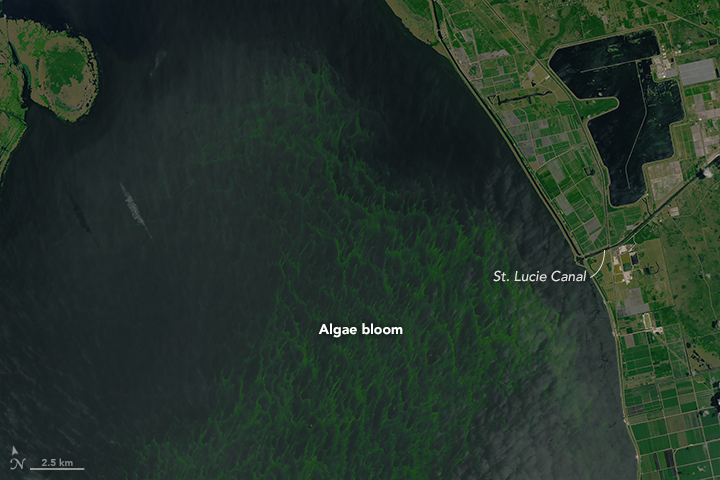


In early May 2016, an algae bloom grew to cover 85 square kilometers (33 square miles) of Florida’s Lake Okeechobee. The conditions that gave rise to the bloom have persisted into July, and have been blamed for affecting water quality downstream all the way to the Atlantic Ocean.
The blue-green algae bloom is visible in this image of Lake Okeechobee, acquired on July 2, 2016, by the Operational Land Imager (OLI) on the Landsat 8 satellite. The natural-color image combines red light, green light, and coastal aerosol (blue) light (bands 4, 3 and 1).
Blue-green algae, also known as cyanobacteria, are single-celled organisms that rely on photosynthesis to turn sunlight into food. The bacteria grow swiftly when nutrients like phosphorus and nitrogen are abundant in still water. The bloom pictured here may contain blue-green algae, as well as other types of phytoplankton; only a surface sample can confirm the exact composition of a bloom.
Algae blooms are a regular phenomenon in Lake Okeechobee during the summertime. Pollution, such as runoff from farms, and lake water that warms through the summer, create an environment favorable for growth. This year the bloom grew large early in the season and it affected more people than usual, showing up far beyond the confines of the lakeshore.
Water managers started discharging water from the lake early this year to counter the large amount of winter rainfall. That discharge flows through St. Lucie Canal—visible on the lake’s eastern side—and enters the Atlantic Ocean near Stuart, Florida. The river outflow carried nitrogen and phosphorous from the lake; it also freshened some downstream areas that are usually too salty for much algae growth. On June 29, Florida’s governor declared a state of emergency in Martin and St. Lucie counties after the blooms appeared in local waterways.
According to news reports, water samples collected from the lake and from the river near Stuart tested positive for high levels of toxins produced by the algae. The algae and their toxins can disrupt ecosystems. They also pose concerns for human health, as ingesting algae-tainted water can cause nausea, vomiting and, in extreme cases, liver failure.
NASA Earth Observatory images by Joshua Stevens, using Landsat data from the U.S. Geological Survey. Caption by Kathryn Hansen.